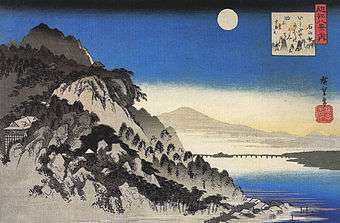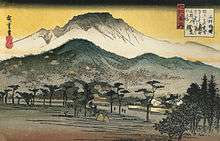Eight Views of Ōmi
The Eight Views of Ōmi (in Japanese: 近江八景 or Ōmi hakkei) are traditional scenic views of Ōmi Province which is now Shiga Prefecture in Japan.
| The autumn moon at Ishiyama | |
|---|---|
 | |
| Artist | Hiroshige |
They were inspired by the Eight Views of Xiaoxiang in China which were first painted in the 11th century and then brought to Japan as a popular theme in the 14–15th centuries. The theme was then used to describe Ōmi province in poetry by Prince Konoe Masaie and his son, Prince Hisamichi, in the 15–16th centuries. The Eight Views of Ōmi then became a popular subject for artists such as Suzuki Harunobu and Utagawa Hiroshige. The theme continued to develop, being transposed to other locations and settings in a process which the Japanese called mitate.[1]
The sights were depicted by Hiroshige in several different series of ukiyo-e pictures, as well as other artists.[2][3]
They are sometimes erroneously called "Eight Views of Lake Biwa", but the latter were defined to include different locations in 1949 by the government of Shiga Prefecture.[2]
The Eight Views
All views are situated at the southern end of the lake. There is no fixed order. The following list circles the lake, beginning on the east side.
- Returning sails at Yabase (矢橋の帰帆) - Yabase. Yabase is an old harbour on the east side of the lake. Near the Tokaido, it was used for a shortcut to Otsu by boat. In the early Meiji era steamers appeared, until the railway began its service.
- Evening glow at Seta (勢多(瀬田)の夕照) - The Chinese Bridge at Seta. The long bridge across the Seta was used by the Tokaido. Nowadays is there a bridge in the old Chinese style, a concrete construction, but nice to walk over. (Today's traffic uses bridges northerly. In the background the "Fuji of Omi", the Mikamiyama. It is just above 400 m, but indeed well visible.
- Autumn moon at Ishiyama (石山の秋月) - Ishiyama Temple. The Ishiyamadera was located on a hillside next to the Seta River. It got his name form the strange rocks on which it is built, partly on supporting beams. A hut at the upper end of the site allows a view of the lake, and the moon.
- Clear breeze at Awazu (粟津の晴嵐) - Awazuhara. Awazu is well known for its pine wood, Awazu-ga-hara. In old pictures the castle of Zeze can be seen. It was given up in the Meiji era and was dismantled.
- Evening bell at Miidera (三井晩鐘) - Mii-dera. Miidera temple was built in the 8th century. Its famous bell is one of the "Three bells of Japan", the other two being those at Byoodo-in, Uji and at Jingoji, Kyoto.
- Evening rain at Karasaki (唐崎の夜雨) - Karasaki Shrine. Karasaki is a small cape with a single large pine tree, a hitsu-matsu. The pine has been replaced several times since Hiroshige's era.
- Wild geese returning home at Katata (堅田の落雁) - Ukimido. Alighting geese cannot be seen always, however the little temple near Katata in the square hōkyō-style, detached from the lakeside, connected by a bridge. The first part of the name uki is the same as in Ukiyo-e, meaning floating. Midō means temple.
- Evening snow at Hira (比良の暮雪) - Hira Mountains. The Hira mountains on the west side of the lake experience the hard winter, when the winter monsoon brings much snow from the continent.
Other Eight views
Hiroshige alone produced nearly 20 different series "Omi hakkei". Other artists followed. To please everybody, "Eight views of" were created for many parts of Japan, e.g. using surroundings of Edo. A series called "Eight views of Kanazawa"[4] reflects a bay near Yokohama.
From the Eight Views of Ōmi by Harunobu (c. 1760)
_%C5%8Cmi_Hakkei_no_Uchi_-_Yabase_Kihan.jpg) Yabase (矢橋帰帆)
Yabase (矢橋帰帆)_%C5%8Cmi_Hakkei_no_Uchi_-_Seta_Sekish%C5%8D.jpg) Seta (勢多夕照)
Seta (勢多夕照)_%C5%8Cmi_Hakkei_no_Uchi_-_Ishiyama_Sh%C5%ABgetsu.jpg) Ishiyama (石山秋月)
Ishiyama (石山秋月)_%C5%8Cmi_Hakkei_no_Uchi_-_Awazu_Seiran.jpg) Awazu (粟津晴嵐)
Awazu (粟津晴嵐)_%C5%8Cmi_Hakkei_no_Uchi_-_Mii_no_Bansh%C5%8D.jpg) Mii Temple (三井晩鐘)
Mii Temple (三井晩鐘)_%C5%8Cmi_Hakkei_no_Uchi_-_Karasaki_Yau.jpg) Karasaki (唐崎夜雨)
Karasaki (唐崎夜雨)_%C5%8Cmi_Hakkei_no_Uchi_-_Katada_Rakugan.jpg) Katata (堅田落雁)
Katata (堅田落雁)_%C5%8Cmi_Hakkei_no_Uchi_-_Hira_Bosetsu.jpg) Hira Mountains (比良暮雪)
Hira Mountains (比良暮雪)
Ukiyoe pictures by Hiroshige
Hiroshige designed the following ukiyo-e pictures:
 Yabase (矢橋帰帆)
Yabase (矢橋帰帆) Seta (勢多夕照)
Seta (勢多夕照) Ishiyama (石山秋月)
Ishiyama (石山秋月) Awazu (粟津晴嵐)
Awazu (粟津晴嵐) Mii Temple (三井晩鐘)
Mii Temple (三井晩鐘) Karasaki (唐崎夜雨)
Karasaki (唐崎夜雨) Katata (堅田落雁)
Katata (堅田落雁) Hira Mountains (比良暮雪)
Hira Mountains (比良暮雪) Hira Mountains (A predrawing by Hiroshige
Hira Mountains (A predrawing by Hiroshige Full moon in Hiroshiges Kanazawa series
Full moon in Hiroshiges Kanazawa series
References
- Hockley, Allen (2003), "Hakkei Series: A Case Study", The Prints of Isoda Koryūsai: Floating World Culture and Its Consumers in Eighteenth-century Japan, University of Washington Press, p. 55, ISBN 9780295983011
- 美しい滋賀県 [The Beauty of Shiga Prefecture] (in Japanese). Ōtsu, Shiga Prefecture, Japan: Shiga Prefecture. 2012. Archived from the original on 2012-05-24. Retrieved Nov 13, 2012.
- "Ōmi Hakkei". Encyclopedia of Japan. Tokyo: Shogakukan. 2012. OCLC 56431036. Archived from the original on 2007-08-25. Retrieved 2012-11-13.
- Not to be mixed up with the city of Kanazawa, Ishikawa Pref.
External links
See also
| Wikimedia Commons has media related to Eight Views of Ōmi. |
- Eight Views
- Eight Views of Xiaoxiang
- Eight Views of Lake Biwa
- Eight Views of Taiwan
- Eight Views of Jinzhou (Dalian)
- Eight Views of Lushun South Road, Dalian
- Eight Views of Korea
- Thirty-six Views of Mount Fuji, by Hokusai and Hiroshige